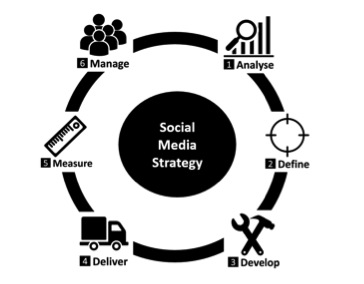#1 Analyse – Know Where You Stand
The first step in social media marketing involves understanding where you currently stand.
By now, virtually every small or large brand would have some social media and online presence. However, few of them would know how successful they’ve been, who they seek to serve, or how they compare with other players in the market.
There are three things you need to do here:
a) Company Social Media Audit
Conduct a comprehensive social media audit to determine how well (or badly) your social media channels like your Facebook page are performing. This would look at Key Performance Indicators (KPIs) like the number of fans or followers you have, frequency of updates, levels of engagement (likes, comments and shares), and number of referrals made to your website.
(As you’d imagine, this may involve getting to know our good friend Google Analytics. Here’s a wonderful guide to Google Analytics for beginners from the lovely folks at Moz.)
b) Customer Persona Development
You need to understand who you wish to target. Describe the demographics (age, education, income, etc), psychographics (interests, lifestyles, and attitudes) and online behaviours of your target customers. Zoom in on how they search for content online, and determine what keywords they use.
(You can learn more at The ABCs of Building a Customer Profile.)
c) Competitor Analysis
Identify which brands your company competes against, and measure how you square against them online. Using tools like Fanpage Karma or Buzzsumo, you can track the frequency of your competitor’s social media posts, engagement of each posts, as well as their most shared content.
#2 Define – Zoom In On Objectives
Next, you need to establish what your goals and objectives for social media are, as well as how your customers search for, locate, engage with and transact with you.
a) Marketing Problem, Objectives and Metrics
With the analysis you have done earlier, you can identify where your current gaps, establish social media marketing goals and objectives, and layer on with suitable metrics to determine success. There are normally three main types of objectives and KPIs here:
- Awareness: Total number of views, impressions (served through ads), reach, and visitors
- Engagement: Likes, comments, shares, and retweets
- Conversion: No of sign-ups, eBooks downloaded, and purchases
Check out our article on the Top 12 Social Media KPIs.
b) Map to Digital Marketing Funnel
Part of defining also involves zooming on your customer journey and where they “land” on your website. You need to understand the role which social media plays in attracting visitors, generating leads and converting them to become your customers.
#3 Develop – Contagious Content and Sticky Communities
Now that you know where you’re going, you need to determine how you can trigger social sharing amongst your targeted communities.
a) Making Your Content “Contagious”
According to Joshua Berger, author of the best-selling book “Contagious”, there are 6 STEPPS to triggering virality and sharing:
- Social Currency: Remarkable facts or news, game mechanics, and making people feel like insiders.
- Triggers: Specific days, seasons, phrases, or contexts of use.
- Emotion: High arousal emotions like awe, excitement and amusement (or even anger).
- Public: Creating a monkey see monkey do effect.
- Practical Value: Offering listicles, tips, guides, and FAQs that help your customers.
- Stories: Using the power of storytelling.
b) Community Management Tactics
If content is king, community must be queen.
Here, you need to craft out your social media community management tactics to recruit online members, engage them, sustain your communities, and develop advocacy amongst your members.
We go more in-depth into what community management is and how to build a framework in this guide.
#6 Manage – Keeping Your House in Order
Finally, you need to manage and sustain your social media marketing activities by incorporating the right resources, policies and procedures to keep things running smoothly. There are four key areas to consider here:
a) Social Media Manpower
Create the right organisational structure and ensure that you’ve got adequate human resources to do the necessary. This covers jobs like social media strategy, content strategist, creative/art director, community manager, and digital analytics.
b) Social Media Budgets
Ensure that you’ve got the right budgets allocated to social media marketing each year, and for each campaign. This would be especially interesting to your CEO and your CFO! Thankfully you already worked out your Social Media ROI and can stand up to scrutiny.
c) Social Media Policies
Are there guidelines for your employees on how they should use social media? What about your Facebook fans? Consider crafting them to minimise ambiguity in managing your social media channels.
d) Social Public Relations
Last, but certainly not least, you need to consider what you should do to continually cultivate influencers, manage “haters” and expand your earned media.




Reader Interactions
3 Comments
in order to acquire the above mentioned 6 steps of social media strategy what courses should be done from your academy
Hi Anchal, you may want to check out our 2-day Social Media Marketing course.
Regards
Trackbacks
[…] have their guards down. If you have a brand new product that no one knows of and search for(yet), Facebook marketing definitely is crucial. On the other hand, Google users have the desire as well as the impetus to […]